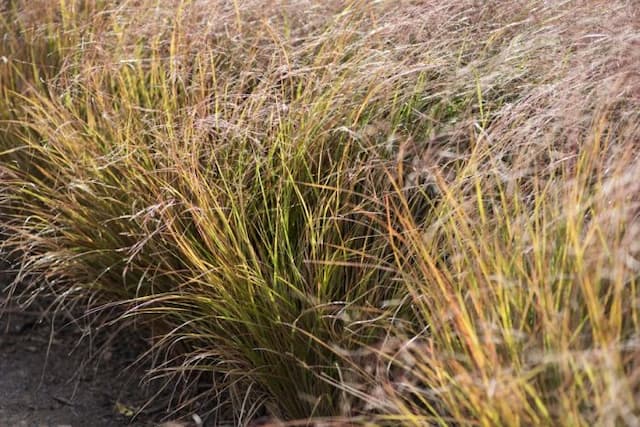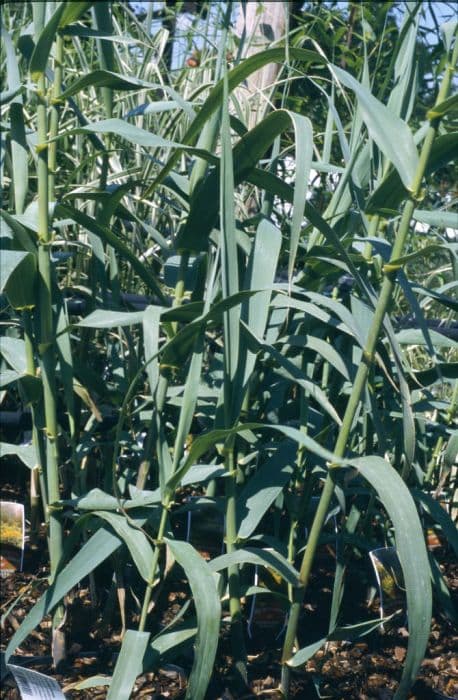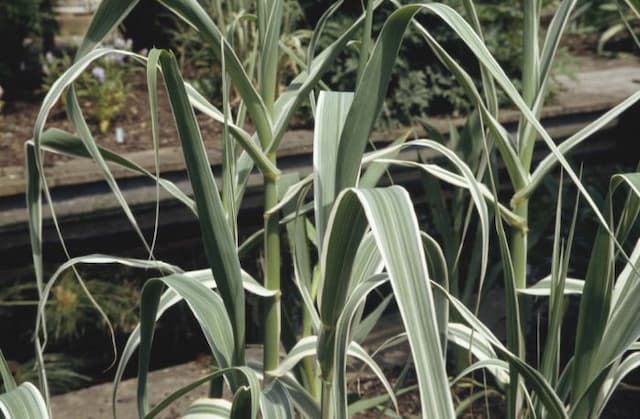Sinuate bamboo Phyllostachys flexuosa

ABOUT
Phyllostachys flexuosa, commonly known as the "Flexible Bamboo," is a striking plant characterized by its distinctive, arched canes. The canes, which are the hallmark of this species, exhibit a beautiful green color and feature a glossy sheen. Over time, the canes mature and may develop into a more yellow-green hue, providing a display of subtle color variation within the clump. The leaves of the Flexible Bamboo are slender and elongated, with a fresh green color that contrasts nicely against the canes. The leaf blades are typically smooth and have a graceful appearance, contributing to the plant's overall elegant and delicate aesthetic. The foliage arrangement is airy and open, allowing light to filter through and creating a soothing, rustling sound when stirred by the breeze. This bamboo species often forms dense clumps, thanks to its underground rhizomes that spread to produce new canes. The canes have a tendency to bend or 'flex,' which is where the plant gets its common name. They also feature distinct, raised nodes that are slightly paler than the internodes, providing additional textural and visual interest. Flexible Bamboo is also known for its resilience and adaptability, which is reflected in its ability to thrive in a range of soil types. This plant is not only valued for its aesthetic qualities but also for its practical uses, including its role in creating screens and hedges in landscaping projects. The natural flexibility and strength of the canes make them a useful resource in areas where flexible building materials are needed. Overall, the Flexible Bamboo is a visually appealing plant that brings a touch of Asian elegance to the landscapes it inhabits.
About this plant
 Names
NamesFamily
Poaceae.
Synonyms
Zigzag Bamboo, Sinuate Bamboo, Winding Bamboo.
Common names
Phyllostachys flexuosa
 Toxicity
ToxicityTo humans
There is limited specific information available on the toxicity of flexible bamboo (Phyllostachys flexuosa) to humans. Generally, bamboo is not considered toxic and is even used in some cultures for food, as in the case of bamboo shoots after proper preparation. However, as with any plant not typically consumed, if someone ingests a part of the flexible bamboo plant that is not generally recognized as edible, it could potentially cause gastrointestinal discomfort or an allergic reaction. Therefore, if symptoms occur after ingesting any part of the bamboo plant, medical attention should be sought.
To pets
The flexible bamboo (Phyllostachys flexuosa) is not commonly listed as a toxic plant to pets such as dogs and cats. Bamboo in general is considered non-toxic to pets, and they may even chew on bamboo without adverse effects. However, ingestion of large amounts could potentially lead to gastrointestinal blockage or irritation due to the fibrous nature of the plant material. If a pet shows signs of distress after ingesting parts of the bamboo plant, consult with a veterinarian.
 Characteristics
CharacteristicsLife cycle
Perennials
Foliage type
Evergreen
Color of leaves
Green
Height
15 feet [4.57 meters]
Spread
6 feet [1.83 meters]
Plant type
Bamboo
Hardiness zones
7
Native area
China
Benefits
 General Benefits
General Benefits- Aesthetic Appeal: Phyllostachys flexuosa, commonly known as Flexuosa bamboo, adds a unique and elegant visual interest to landscapes with its arching canes and vibrant green foliage.
- Privacy Screening: The dense growth pattern of Flexuosa bamboo makes it an excellent natural screen, providing privacy for gardens and yards.
- Noise Reduction: The thick foliage and canes of the bamboo help to absorb sound, making it a good choice for creating a peaceful, quieter garden space.
- Erosion Control: The strong root system of Phyllostachys flexuosa helps to stabilize the soil, preventing erosion on slopes and along water banks.
- Windbreak: The sturdy canes of this bamboo species make an effective windbreak, protecting other plants and reducing wind speeds in the immediate area.
- Habitat Creation: Flexuosa bamboo provides shelter and food for a variety of wildlife, such as birds and insects, enhancing biodiversity.
- Fast Growth: As a fast-growing plant, Phyllostachys flexuosa can quickly establish itself, making it an excellent choice for new gardens or when immediate impact is desired.
- Renewable Resource: Bamboo is a renewable resource that can be harvested for crafts, building materials, and other sustainable products without harming the environment.
- Culinary Use: Although not the primary use of Flexuosa bamboo, the young shoots of some Phyllostachys species are edible and can be used in Asian cuisine.
 Medical Properties
Medical PropertiesThis plant is not used for medical purposes.
 Air-purifying Qualities
Air-purifying QualitiesThis plant is not specifically known for air purifying qualities.
 Other Uses
Other Uses- Phyllostachys flexuosa, commonly known as Zigzag Bamboo, can be fashioned into musical instruments such as flutes and percussion sticks due to its hollow structure and resonance quality.
- This bamboo's split canes can be used to make intricate weavings for decorative screens or panels, showcasing its natural beauty and flexibility.
- With its unique zigzag growth pattern, Zigzag Bamboo can be trained to grow into living art forms, such as topiaries or garden sculptures, adding a creative touch to landscapes.
- Bamboo shoots of Zigzag Bamboo are edible and can be harvested for culinary use in a variety of dishes, adding a crunchy texture and nutritional benefits.
- The hard wood of Zigzag Bamboo can be used to craft durable furniture, providing a sustainable and environmentally friendly option for home furnishings.
- Its robust canes may be utilized for building sturdy fences or trellises in gardens, supporting other plants and providing structure to outdoor spaces.
- Due to its growth habit, Zigzag Bamboo can be used to create effective wind breaks or privacy screens, making it suitable for use in landscape design.
- The long bamboo poles of Zigzag Bamboo can be used in construction for scaffolding, as they are both lightweight and strong.
- Zigzag Bamboo's durability and flexibility make it suitable for crafting traditional fishing rods, melding modern functionality with an artisanal approach.
- By using Zigzag Bamboo in textile production, fibers can be extracted to make soft and breathable bamboo fabric for clothing and linens.
Interesting Facts
 Feng Shui
Feng ShuiThe plant Phyllostachys flexuosa, commonly known as the zigzag bamboo, is not used in Feng Shui practice.
 Zodiac Sign Compitability
Zodiac Sign CompitabilityThe zigzag bamboo is not used in astrology practice.
 Plant Symbolism
Plant Symbolism- Resilience: Phyllostachys flexuosa, commonly known as bamboo, is notably resilient and adaptable, symbolizing the ability to withstand adversity and bounce back from difficulties.
- Flexibility: The name 'flexuosa' suggests flexibility. Like bamboo that bends in the wind, it represents the importance of being flexible and adaptable in life without breaking under pressure.
- Growth: Bamboo is one of the fastest-growing plants in the world, making it a symbol for rapid growth and the swift progression through life's stages or personal development.
- Longevity: Bamboo is known for its long life, making it a common symbol of longevity and the desire for a healthy, long life.
- Peace: In many cultures, bamboo forests are places of tranquility and peace, and thus bamboo can symbolize the search for inner peace and meditation.
- Strength: Despite its flexibility, bamboo is incredibly strong. As a symbol, it conveys the idea that true strength is the combination of both resilience and flexibility.
- Prosperity: In some Asian cultures, bamboo is associated with prosperity and is often used in Feng Shui to attract wealth and abundance.
 Water
WaterZigzag bamboo should be watered enough to keep the soil consistently moist, but not waterlogged. In general, watering once a week with 1 to 1.5 gallons of water per plant is a good starting point. However, this frequency may need to be increased during hot, dry periods or if the bamboo is planted in well-draining soil. It is essential to reduce watering during the cooler months to prevent root rot. A thorough soaking at the base of the plant is the best method, allowing the water to penetrate deeply into the root system.
 Light
LightZigzag bamboo thrives best in full to partial sunlight. The ideal spot for the plant is an area that receives at least four to six hours of direct sunlight per day, with some dappled shade during the hottest part of the afternoon. However, they can tolerate some shade, particularly in hotter regions.
 Temperature
TemperatureZigzag bamboo prefers moderate temperatures and can tolerate a range between about 20°F and 95°F. The ideal temperature range for optimal growth is between 50°F and 80°F. They can survive brief periods of colder weather down to around 15°F, but prolonged exposure could be damaging.
 Pruning
PruningZigzag bamboo requires pruning to maintain shape, remove dead canes, and encourage new growth. The best time to prune is in the spring before new shoots emerge. Prune annually or as necessary by cutting canes at ground level to thin out the clump and enhance air circulation.
 Cleaning
CleaningAs needed
 Soil
SoilFor Zigzag Bamboo, the best soil mix is well-draining with good fertility. A mixture of loamy garden soil, compost, and sand or perlite promotes healthy growth. The ideal soil pH is slightly acidic to neutral, ranging from 6.0 to 7.0.
 Repotting
RepottingZigzag Bamboo should be repotted every two to three years to prevent root bounding and to refresh the soil, ensuring adequate nutrients for growth.
 Humidity & Misting
Humidity & MistingZigzag Bamboo thrives in moderate to high humidity levels, ideally between 40% to 70%. It can tolerate lower humidity but may not grow as vigorously.
 Suitable locations
Suitable locationsIndoor
Place Zigzag Bamboo in bright light, water when soil is dry.
Outdoor
Plant in fertile soil, partial shade to full sun, water regularly.
Hardiness zone
7-10 USDA
 Life cycle
Life cyclePhyllostachys flexuosa, also known as the Zigzag Bamboo, begins its life cycle as a seed, which after germination grows into a seedling with the characteristic bamboo shoot. This shoot rapidly elongates, powered by its rhizome system, to form a culm that hardens and begins to branch out as it matures. Once the culm fully matures, which can take several years depending on environmental conditions, it produces foliage leaves essential for photosynthesis and sustenance. The Zigzag Bamboo can then enter a period of vegetative growth, spreading asexually through its underground rhizomes and overground culms that lean and sometimes root when they touch the ground, thus exhibiting the zigzag pattern that gives the bamboo its name. After several years, Zigzag Bamboo will flower, although this occurs very rarely and can lead to the plant's death as many bamboo species invest significant energy into producing flowers and seeds. The seeds produced can then disperse, starting a new cycle if they find suitable conditions to germinate and grow.
 Propogation
PropogationPropogation time
Spring-early summer
The most popular method of propagation for Phyllostachys flexuosa, commonly known as the Chinese bamboo, is through division. This is typically done in late winter to early spring just before the growing season starts. To propagate by division, a healthy, mature clump of bamboo is selected, and a sharp spade is used to slice through the root mass to separate a section with at least one or two viable culms (bamboo stems) and an ample amount of root mass. This division should then be immediately transplanted into a prepared hole that can comfortably accommodate the root ball. It is crucial to water the new plant thoroughly after planting to help establish it in its new location.









